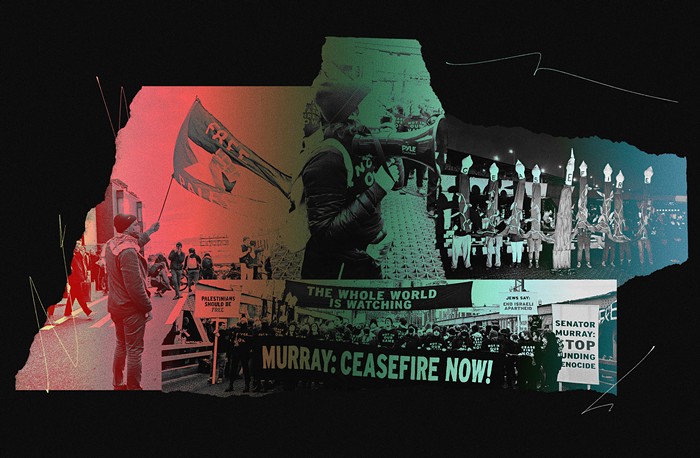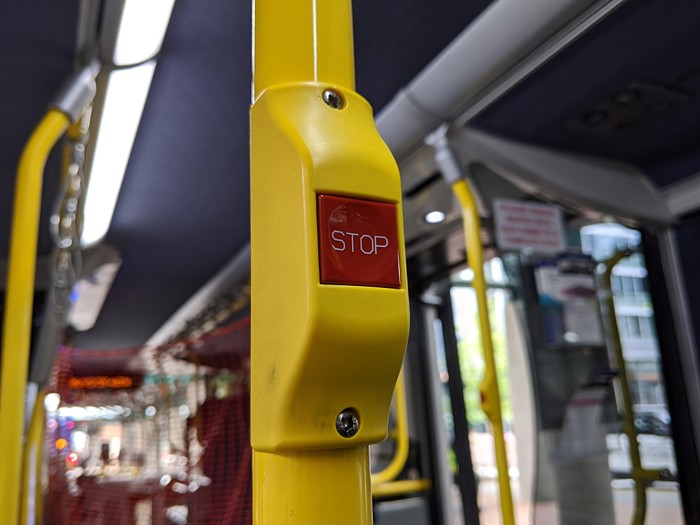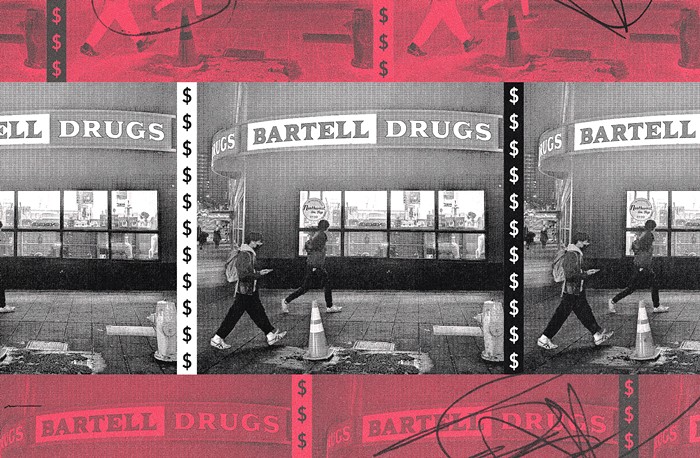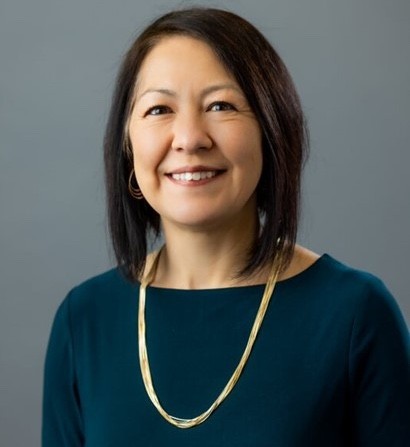
As Heidi mentioned this morning, a panel of local journalists assembled last night at the Rainier Arts Center to discuss diversity (or, really, the lack thereof) in journalism. The panelists: Yes! Magazine editor Yessenia Funes, The Seattle Globalist's Venice Buhain, news editor, and Christina Twu, community engagement editor; and the Seattle Times' Tyrone Beason, editor of their Pacific Northwest Magazine, and Jerry Large, columnist.
According to The Atlantic:
92 percent of journalists were white in 1992, and 92 percent of journalists were white in 2012.
Minorities made up 21.4 percent of graduates with degrees in journalism or communications between 2004 and 2014, but less than half of minority graduates found full-time jobs, while two-thirds of white graduates did.
Here was the conversation, in tweets.
Why is #JournalismSoWhite? Let's talk about it. pic.twitter.com/q9rzZRBFNd
— Heidi Groover (@heidigroover) April 13, 2016
In 3 decades journalism has gone from being predominantly white & male, to predominantly white & male says @mhgreen3000 #JournalismSoWhite
— Tamara Power-Drutis (@TamaramaPD) April 13, 2016
Its outrageous/racist/classist how little this society values nosy, critical, truth-tellers of color. #JournalismSoWhite #flipatable ALREADY
— joaquin uy (@joaquinuy) April 13, 2016
And one of the first barriers for writers of color entering newsrooms is the hiring process.
Does the problem stop at hiring, or is it systemic asks @KnuteBerger at #journalismsowhite @Crosscut @SeaGlobalist pic.twitter.com/uuCyOQcphW
— Cambria Roth (@CambriaRoth) April 13, 2016
.@SeaGlobalist's Christina Twu says there are plenty journalists of color out there – they're just not being hired. Lack of talent is a myth
— Ana Sofia Knauf (@asknauf) April 13, 2016
Twu: hiring is only a start. once you're in a newsroom, pigeonholing is an act of marginalization
— Clayton Aldern (@compatibilism) April 13, 2016
On compensation for journalists trying to get started in their career:
When @KnuteBerger asks if young news colleagues are struggling and @jerrylarge pauses, woman shouts "we're struggling!" #JournalismSoWhite
— Caley Cook (@caleycook) April 13, 2016
The current economics of journalism play big part in dearth of journalists of color paid living wages for their work #JournalismSoWhite
— Naomi Ishisaka (@naomiishisaka) April 13, 2016
The journalists on stage talked about how none of them got into this business for the money.
Journalism was never something we go into for the money says @jerrylarge #JournalismSoWhite @seattletimes
— Tamara Power-Drutis (@TamaramaPD) April 13, 2016
.@yessfun: Because of how poorly people are paid, the people who stick w journalism are in it bc they're doing what they love to do 🙌🏽
— Ana Sofia Knauf (@asknauf) April 13, 2016
But there's a flip-side to that, too:
So what I heard is that: POC journalists should be dedicated enough to not want to get paid #JournalismSoWhite
— Naomi Ishisaka (@naomiishisaka) April 13, 2016
No mention of outrageous student debt or the fact that journo wages are stagnating compared to other fields. https://t.co/Jh6B4vfoit
— Hanna Brooks Olsen (@mshannabrooks) April 13, 2016
I pay $1,200 in rent & $800 in student debt every month. I cannot afford to be a full-time journalist. Which sucks because I fucking love it
— Hanna Brooks Olsen (@mshannabrooks) April 13, 2016
Let's be real. Capitalist society pours more money into things it values most. America doesn't value journos/journalism. #JournalismSoWhite
— joaquin uy (@joaquinuy) April 13, 2016
I know the #JournalismSoWhite panelists said 2 write 4 the love, not money.
But fuck that. Get paid. I'm serious. Don't do it without money
— Ijeoma Oluo (@IjeomaOluo) April 13, 2016
After all, making journalism a financially viable career for journalists of color is key to flipping tired narratives:
Tyrone Beason: I didn't learn to be compassionate in J-school. But compassion is so important in our work. #JournalismSoWhite
— Ana Sofia Knauf (@asknauf) April 13, 2016
Beason: Better to be a fair and compassionate witness than to adhere to "objectivity," a lazy approach that masks white supremacy and bias
— Ansel (@Ansel) April 13, 2016
Tyrone Beason: this town was built on white narratives. #JournalismSoWhite panel.
— Aaron Burkhalter (@AaronBurkhalter) April 13, 2016
Changing white centric narratives includes changing the way we think about "bias" as a journalistic value. @TwuTweets #JournalismSoWhite
— Martha Tesema (@martesema) April 13, 2016
Recent debacles at the Seattle Times loomed large—e.g. its treatment of musician Hollis Wong-Wear, the way a columnist questioned Marshawn Lynch's classiness, and most recently, its callous, one-dimensional portrayal of Michael Flowers, a young man murdered in Renton—though none of those examples were named directly. Beason said he's feeling "tough love" for the paper these days.
Tyrone Beason says there's an internal struggle at @seattletimes to cover communities of color in ways that don't do harm.
— Ansel (@Ansel) April 13, 2016
Columnist Jerry Large gave the audience a glimpse into how that struggle has played out: He once told photo editors that their photos of the South end were one-dimensional and overly negative, while, at the same time, photos of the North end portrayed of mostly white people in a positive and multi-dimensional way. His complaint was dismissed, but a few years later, after the hiring of more people of color to the newsroom, more voices agreed with him. The editors finally agreed to keep a tally of negative and positive images from the areas printed in the paper, and sure enough, it proved the disparity was real.
But the proportion of people of color at the paper has gone down since then, not up, Large said. People of color made up 20.8 percent of the Times newsroom in 2015—a nearly two percent drop from 2004.
So when journalists and editors publish stories that are insensitive or damaging to people of color, what should we do?
.@IjeomaOluo asks how editors/writers (esp white editors) are held publicly accountable when they are insensitive to POC #JournalismSoWhite
— Ana Sofia Knauf (@asknauf) April 13, 2016
.@IjeomaOluo addressing need for transparency/accountability in process with mistakes in newsrooms. 👏🏾 *cough cough* #NotYourAsianSidekick
— Martha Tesema (@martesema) April 13, 2016
You should be grateful when readers have criticism, it's an opp to learn more says @venicebuhain #JournalismSoWhite pic.twitter.com/6tKbf76QBA
— Tamara Power-Drutis (@TamaramaPD) April 13, 2016
At the end of the day, journalists are people that make mistakes, so tell us when we do says @yessfun #JournalismSoWhite
— Tamara Power-Drutis (@TamaramaPD) April 13, 2016
And, ultimately:
It's beautiful to see such a racially diverse audience for the #JournalismSoWhite panel discussion. #mediajustice pic.twitter.com/lJfjcgxW5x
— Michael B. Maine (@michaelbmaine) April 13, 2016
As for The Stranger, our publisher, Tim Keck, made a promise earlier this year about disclosing our newsroom's gender and racial makeup, as Buzzfeed does. He told Ansel in February:
"I think it's a good idea and we'll start publishing that info this year," he said. "I'll work with the staff on the best way to collect and share the data."
We're still working on it.
I gotta follow up with @timothykeck about publishing @strangerslog full staff demographic data. Need to beat @seattletimes on that.
— Ansel (@Ansel) April 13, 2016


















